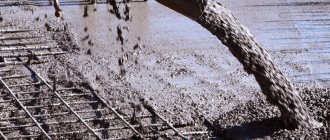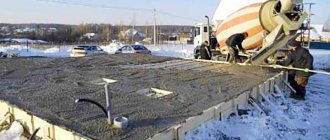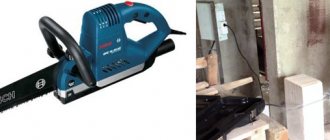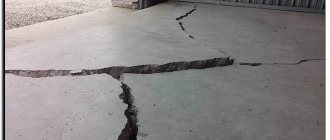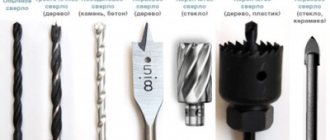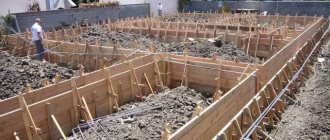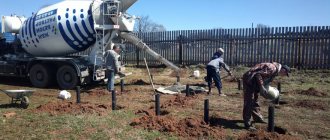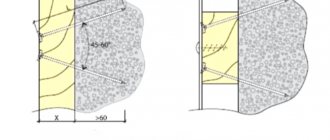- February 23, 2020
- Construction
- Daisy Angel
Concrete is one of the most popular materials in construction. The most suitable conditions for its hardening are considered to be an ambient temperature of + 20 ˚С. But sometimes you have to pour concrete at sub-zero temperatures. In this case, it is better to use the services of specialists.
Water can become an obstacle to quality work. It is needed in concrete not only for fluidity. Water performs an important function in the hardening process. At low ambient temperatures, it changes from a liquid state to a solid state (turns into ice). This stops the hardening process and promotes the destruction of bonds formed before freezing.
Concrete can harden even at a temperature of -4 °C. However, if it drops below + 5 ˚С, then the hardening process slows down, and the strength gain is suspended and resumed only when it becomes warmer outside. The longer the stagnation in the hardening process, the less strength the material will gain. This means that at low temperatures it is necessary to provide conditions under which the concrete will not freeze and will continue to gain strength.
Use of additives
If you are interested in knowing how to pour concrete at sub-zero temperatures, then you should familiarize yourself with the technology of using additives. Antifreeze substances are not very expensive and are widely available. If you purchase ready-made concrete, then all additives should already be in it. In this case, the temperature values in a specific area are taken into account.
Additives contain chemical impurities - salts of monocarboxylic acids, sodium formate and nitrite. They speed up the hardening process, prevent water from freezing, and also increase the final strength of the material. The main disadvantage of using various additives is that such substances cope with their work only at -5 ˚С. If you are interested in at what negative temperature concrete can be poured, then you should know that in severe frosts, although some additives will work, hardening will not begin as quickly as required by technology. Ultimately, the lack of strength can be 30%. Some additives are aggressive towards metal reinforcement. They destroy it, causing the structure to lose strength.
Making your own winter solution
First, mix the dry components, then add liquid ones.
The masonry mass is prepared in a concentration of 1:3 (cement and river sand, respectively) . The cement is taken dry, the sand is sifted before adding. Modifiers are added according to the instructions, carefully calculating their quantity.
The temperature in the room where the mixture is prepared should be positive, then the finished solution is moved to the site where the wall is being erected.
First, the components are mixed dry, then water and additives are added. Recommended water temperature +15 – 20°C. Mix the amount of mixture that can be produced in an hour. After this time, the mass dries out and begins to harden.
Benefits of Using Supplements
Many people want to know how to pour concrete at sub-zero temperatures. In order not to make a mistake, you first need to familiarize yourself with all the advantages and disadvantages of a particular method. The most common technology is the addition of additives. They have one significant advantage - this approach allows concreting to be carried out at any time of the year.
Using additives, it is possible to transport concrete mortar at low temperatures. To ensure high-quality setting of the material, it is not necessary to use additional heating systems. When antifreeze additives are added, a concrete monolith receives additional strength, and the solution consumption is reduced (if compared with a material prepared according to a conventional recipe).
Frost protection
Work to protect a concrete monolith consists of several methods:
- adding antifreeze additives to the solution at the production stage;
- working with certain brands of cement, the hydration of which occurs with the release of heat;
- as an option, introducing calcium chloride into the batch, it speeds up the hardening process by half;
- possible heating of the formwork to above-zero temperatures so that the cement mixture does not have time to freeze;
- treating the surface of the poured mass with special liquid sealants. The treated surface, for example a foundation, is covered with a liquid film that prevents heat evaporation. The solution is in the process of hydration. heats itself;
- Using warm water at the stage of mixing the solution will extend the hardening time of the monolith.
Important - experts do not recommend using hot water above 60 degrees. This temperature can lead to very rapid uneven solidification of the entire mass. Such a product will be unsuitable for further use.
To protect the foundation from freezing and extend its hardening time, a simple method is used - sawdust and straw are poured onto the surface and covered with film or tarpaulin. The side surfaces are treated with waterproofing materials; they can be covered with slate or cardboard.
An educational article on this topic can be found here: Pouring concrete at sub-zero temperatures - features and technology
The main disadvantages of antifreeze additives
In order to pour concrete at sub-zero temperatures without compromising the quality of the material, it is necessary to become familiar with the disadvantages of anti-frost additives. Firstly, they can lead to the appearance of salt crystals on the surface, which are almost impossible to remove. Secondly, sometimes they reduce the strength of concrete stone. This happens if the proportions are calculated incorrectly, and the cooking or setting technology is broken. Thirdly, individual components may be unsuitable for use in residential areas as they are toxic.
Difficulties in laying bricks in frosty weather
The difficulty of winter masonry that determines all problems lies in the freezing of the cement mass, or rather the water contained in it. This disrupts normal hydration processes and the strength of the solution loses about a quarter of the required norm. This circumstance leads to inadequate adhesion of building elements, which directly affects the overall stability of the building. It decreases, and this can lead to unpleasant, sad consequences.
In addition, changes in temperature and humidity will cause:
- destruction of the structure of bricks from the process of freezing moisture in them;
— formation of a thin ice crust on the surfaces of the elements being connected;
- the formation of numerous voids in the solidified solution after temperature normalization.
Finding, let alone living in such a house becomes dangerous.
Attention! If you correctly follow some “winter” principles of laying bricks, then there will be no problems with quality construction and the structure will be reliable!
Heating technology
Many novice craftsmen do not know at what temperature concrete should be heated. It is important to take into account one rule: if the thermometer drops below + 5 ˚С, then the hardening process slows down. To avoid this, heating must begin when the ambient temperature drops below this mark. You can do this as follows:
- pass current through the concrete using an electrode;
- pass current through a wire pre-laid inside the material.
The first method is cheaper, since metal rods can act as electrodes. If you follow the rules, you will need special equipment for these purposes. However, some craftsmen connect a welding machine to the reinforcing electrodes, passing current through the solution and heating it. Reinforced concrete is heated at a voltage of up to 127 V. Without metal reinforcement, voltages of up to 380 V should be used.
The second method involves additional costs for the heating cable. It is laid with a reinforcement frame. Current is connected to it through substations. This method is more expensive, but is more effective compared to heating using electrodes.
The main disadvantage of the above method can be called financial costs. In addition, when heating, you need to constantly monitor the temperature. If it rises excessively, this will cause the material to dry out and may compromise the strength of the structure. If frosts are severe, the formwork should be additionally insulated. Now you know at what temperature you need to heat concrete.
Warming during hardening
It is allowed to use conventional insulation methods. This is true if the ambient temperature is not lower than 5 degrees Celsius. Most often, the formwork (if any) is insulated, as well as visible parts of the concrete. For this purpose, you can use all kinds of materials, such as sawdust or polystyrene foam.
One of the most popular ways is to create a tent around the object. Heating guns can be installed inside such a structure. This method has the disadvantage that the concrete must be at a predetermined temperature when supplied. In addition, conventional insulation without additional heating will be ineffective if there is severe frost outside.
Types of antifreeze additives
To pour concrete at sub-zero temperatures, which additive should I choose? The following types of these products are available on the market:
- Antifreeze.
- Sulfates.
- Antifreeze additives.
Antifreezes are substances that reduce the crystallization temperature of a liquid and speed up the setting time of the material. Sulfates are additives that accelerate hardening as much as possible and generate heat, so that the components of the solution mix faster and become a homogeneous mass. This lowers the freezing point. On sale you can find antifreeze additives called accelerators. These components are able to increase the rate of dissolution of silicate components, which react with the products of solution hydration. This ensures the formation of basic and double salts, which reduce the freezing point of the mixture.
Antifreeze additive CemFrio
Among the inexpensive offers on the market, CemFrio should be highlighted. It is designed to increase the strength of material poured at sub-zero temperatures. This complex additive is used not only for concrete, but also for other mortar mixtures. It accelerates hardening and provides a plasticizing effect. Concreting with its use can be carried out at temperatures up to - 20 ˚С.
Prefabricated monolithic or monolithic concrete, as well as reinforced concrete structures can be erected with its help. The additive prevents the possibility of their destruction when exposed to negative temperatures. This substance should be dosed with a larger margin, focusing on the approximate readings of the thermometer during the day (not only during the day, but also at night) throughout the entire stage of hardening of the solution. In this case, the strength gain of concrete at sub-zero temperatures will be ensured in the range from + 10 to - 20 ˚С. At the same time, the need to add water to mortar mixtures is reduced by 5%, and the strength characteristics increase by 10%.
Freezing method
The method is applicable for the construction of buildings up to 4 floors and a height of ≤ 15 m. The essence is to use conventional mortars to ensure their initial setting, which is ensured by heating water to 80 degrees and sand ≤ 60°C, further strengthening occurs upon the onset of thaws.
The following requirements must be strictly observed:
- at the time of installation, the temperature of the solution should be: with an average daily temperature of up to - 10° - plus 5°; to minus 20° - +10° and 15° at temperatures below -20°C. In the first 2 cases, a grade of mortar is used higher than the design one by one; in the third, the excess should be two grades;
- Bricklaying in winter is carried out throughout the entire area at the same time;
- per mile, the mortar is laid immediately on a maximum of two adjacent bricks, on a backfill ≤ 8;
- the finished solution should be applied for ≤ 30 minutes;
- the mason's mortar container must have a lid, be heated or insulated;
- a frozen solution cannot be used; heating it by adding hot water is unacceptable;
- It is prohibited to remove frozen ice crust on the walls with hot water; you can use a blowtorch or hot steam, which will additionally heat the bricks;
- after completing the daily laying, the grip is covered with heat insulators;
- Before the thaw, everything unnecessary (equipment, tools, building materials and debris) is removed from the floors.
How to heat concrete yourself
Now you know that you can pour concrete in cold weather in different ways. If you do not want to use the appropriate additives, use the solution heating method. For this purpose, they most often work with electrodes. This is due to the simplicity and low cost of the method, because there is no need to use heating wires and transformers. This method is based on the physical properties of electric current, which passes through a conductor and releases a certain amount of heat.
The conductive material is concrete. When current passes through a water-containing solution, it heats it. If the concrete structure contains a reinforcement frame, it is not recommended to apply a voltage of more than 127 V to the electrodes. If such a structure does not exist, you can use both 220 V and 380 V. It is not recommended to apply a higher voltage.
If we pour concrete in cold weather, we can use different materials for heating, for example, rod electrodes. To create them, you should take metal reinforcement with a diameter of 8 to 12 mm. Such rods are inserted into concrete at a certain distance from each other and connected to different phases.
If the design is complex, heating electrodes will be indispensable. Fiberglass reinforcement is not suitable for such purposes, since it is a dielectric. Electrodes in the form of plates can be used. In this case, the heating circuit is very simple. The plates must be placed on opposite sides of the poured solution and connected to different phases. The passing current will heat the concrete.
Sometimes craftsmen use narrow stripes. The principle of their operation is the same as that of the plates. Electrodes can also be string electrodes. They are used when pouring columns, pillars and beams. The principle of operation is similar. The strings should be connected to different phases. Warming up with electrodes must be carried out with alternating current, since direct current passing through water promotes electrolysis. In this case, the water will chemically decompose without fulfilling its role in the hardening process. Now you know whether concrete is poured at sub-zero temperatures.
Infrared and induction methods
If you are thinking about how to pour concrete in sub-zero temperatures, you can also use the induction method. It is mainly used in crossbars, beams and purlins. This method is not very common due to the complexity of the device. It consists in the fact that the insulated wire creates induction and heats the fittings around which the element is wound.
Warming up using infrared rays is based on the ability of the latter to heat the surface of transparent objects with heat transfer throughout the volume. When using this method, the concrete should be wrapped in a transparent film, which will transmit the rays through itself, preventing the heat from quickly evaporating. The advantage of such heating is that transformers do not need to be used. The method also has a drawback. It is expressed in the inability of infrared radiation to uniformly heat large structures.
If you plan to pour concrete in sub-zero temperatures, you should know that the method described above is only suitable for thin structures. Regardless of what type of electric heating is used, you need to monitor the temperature. If it rises above +50˚C, it will create dangerous conditions. The heating rate (as well as cooling) should not exceed 10 ˚C per hour.
Floor screed
In order to create a fairly even floor surface, a cement-based mortar is used. This work is quite complex and requires increased attention. The floor screed is laid on a base made of a layer of crushed stone or gravel.
Cement calculation
For work such as floor screed, only two grades of cement are used: M-200 or M-150. For the floor, you can purchase an already prepared mixture that already contains plasticizers. But this option can cost much more. When using cement, grade M-150, take one part of cement and about three parts of sand. When using material with the M-200 grade, one part of cement and two parts of sand are most often taken.
What other substances can be used to heat concrete mortar?
We looked at how many degrees below zero it is possible to pour concrete. It should be said that antifreeze additives are most often used. Among others, it is allowed to use calcium carbonate, which is also called potash. This crystalline antifreeze component accelerates the hardening of concrete and is recommended for use exclusively together with sodium tetraborate (sulfide-yeast mash). Many people know it better under the name “borax”.
Calcium carbonate added in its pure form may reduce the strength of the structure. The amount of sodium tetraborate and mash should be no more than 30%. When choosing additives for concrete at sub-zero temperatures, you must take into account that potash is a dangerous substance. It can only be used in compliance with safety precautions. Sodium tetraborate can be used as a stand-alone additive. This additive is a mixture of sodium, ammonium and calcium salts. The sodium tetraborate impurity preserves the structure of the structure. Borax eliminates the occurrence of cracks and reduces the water permeability of concrete. Its strength increases by 30%.
